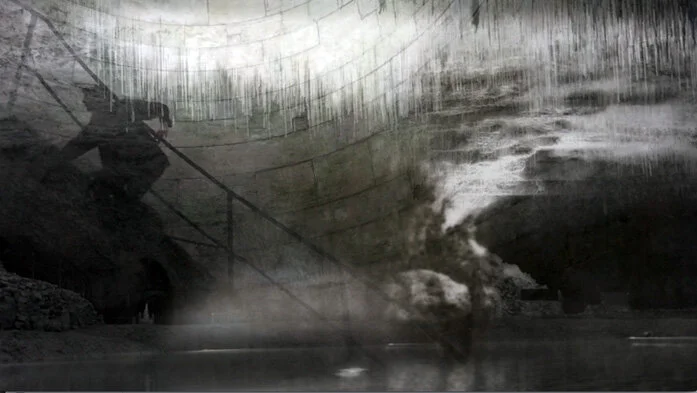COLLABORATION WITH ANTHROPOLOGIST GERMAIN MEULEMANS
SOUND DESIGN: FLORIANE POCHON
IS PARIS FLOATING ?
2019
Video installation, HDV, Col, multichannel
View from the installation, Inverted periscope projection, Musée des Arts et Métiers, Paris / Vue de l’installation, Projection en périscope inversée, Musée des Arts et Métiers, Paris
COLLABORATION AVEC L’ANTHROPOLOGUE GERMAIN MEULEMANS
SOUND DESIGN: FLORIANE POCHON
PARIS FLOTTE-T-IL ?
2019
installation vidéo, HDV, Col, multicanal
Sous la forme d’une installation, cette fiction est née d’une enquête dans les profondeurs de Paris et révèle une ville dont les fondations ressemblent étrangement à des coques de navires, faisant émerger la question : Paris flotte-t-il ?
L’eau s’obstine à s'infiltrer entre les pierres du dallage des petits et grands bâtiments parisiens. Un sourcier tente de lever le mystère en recherchant une source ou les traces d’une rivière souterraine sous le Musée des Arts et Métiers.
Depuis un promontoire évoquant un autel, une dalle ouverte offre une vue plongeante sur un effondrement dans le sol. En suivant les pérégrinations du personnage, le visiteur est aspiré dans les profondeurs sous le musée des Arts et Métiers et Cnam jusqu’aux anciennes «sources du Nord», à Ménilmontant, qui alimentaient jadis le prieuré Saint-Martin-des-Champs. Par ce dispositif immersif d’une durée d’une quinzaine de minutes projeté sur les murs et le sol, le visiteur est convié à une expérience sensorielle et cognitive dans un Paris révélé en cité lacustre bâtie sur pilotis.
Ce projet a été développé lors d’une résidence au Musée des Arts et Métiers, Paris.
== > CATALOGUEUnder the form of an installation, this fiction has emerged from a fieldwork under Paris and reveals a city whose foundations strangely resemble ship hulls, raising the question : is Paris floating ?
In the chapel of former priory of St Martin-des-champs, now water stubbornly seeps in between the paving stones. A dowser tries to unveil the mystery by searching for a spring, and hears the story of an underground river, only to be swallowed by the ground.
From a promontory evoking an altar, the installation constructed around an open slab offers a view into the depths of the ground. Following the journey of the character, the visitor is lead under the Musée des Arts et Métiers up to the "sources of the North" in Belleville, which once supplied in water the priory where is located the museum. Through this immersive filmic installation, the visitor comes to experience Paris as a lacustrian city built on piles.
This project was developped as part of a residency at Musée des Arts et Métiers, Paris.
View from the video installation, Is Paris floating ?, Screen 1 / Vue de l’installation vidéo, Paris flotte-t-il ?, Écran 1
View from the video installation, Is Paris floating ?, Screen 2 / Vue de l’installation vidéo, Paris flotte-t-il ?, Écran 2
View from the video installation, Is Paris floating ?, Screen 3 / Vue de l’installation vidéo, Paris flotte-t-il ?, Écran 3
View from the video installation, Is Paris floating ?, Screen 4 / Vue de l’installation vidéo, Paris flotte-t-il ?, Écran 4
Ce projet a été présenté pour la première fois comme installation in-situ développée pour et avec la Tour Chapelle, espace méconnu des visiteurs, au Musée des Arts et Métiers, Paris.
Cette installation a pris corps durant une enquête menée par l'anthropologue et l'artiste sous la ville de Paris, interrogeant l’apparente «solidité» des sols de la ville. Ils sont descendus dans le puit situé sous l'esplanade du musée et ont glissé dans les sous-sols du Conservatoire aménagés sous la nappe phréatique, où des stations de pompage évacuent en permanence l’excédent d'eau.
En suivant la piste de l’existence hypothétique de ruisseaux souterrains irriguant le quartier Arts et Métiers, ils se sont aventurés dans les passages souterrains et les carrières de Paris, à la rencontre des travailleurs qui entretiennent et consolident les fondations de la ville. Ils ont également rencontré des chercheurs, spécialistes de la géotechnique - une discipline «invisible» sans laquelle il n’y aurait pas de grandes constructions à la surface. Leur périple s'est achevé au regard de la Lanterne où l’on peut encore voir les vestiges de la rivière et de l’aqueduc de Belleville qui fournissait l’eau au prieuré.
At the intersection of art and anthropology, this installation was conceived on the basis of fieldwork conducted under Paris.
During a residency of three month at Musée des Arts et Métiers the artist and anthropologist questioned the apparent ‘solidity’ of soils in the city of Paris. They climbed down the well located under the forecourt of the museum, and slide into the basements built under the water table, where pumping stations constantly pump out excess water. Following traces of the hypothetical existence of underground streams which irrigate the Arts et Métiers district, they ventured into the underground passages and carreys of Paris, meeting the workers who maintain and consolidate the foundations of the city. They also met researchers, specialists in geotechnics – an ‘invisible’ discipline without which there would be no tall constructions at the surface. Their journey ended on the heights of Belleville, in the aqueducts that provided water to the priory.
This piece was first exhibited as a site specific installation developped for the Tour Chapelle, Musée des Arts et Métiers, Paris.
“What on earth is the ground ? It is a surface, says the dictionary, upon which things or persons stand or move. But this leaves many questions unanswered. What kind of surface is this ? Does it have one side or two ? Does it cover the earth or cover it up ? Can it have holes ? What lies beneath ? ”





